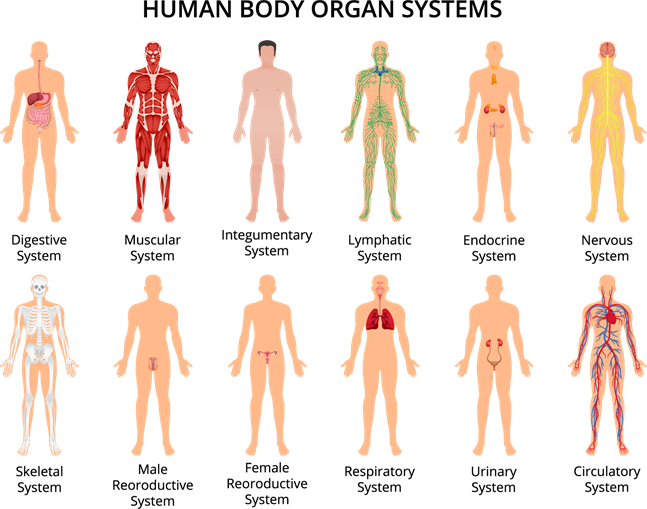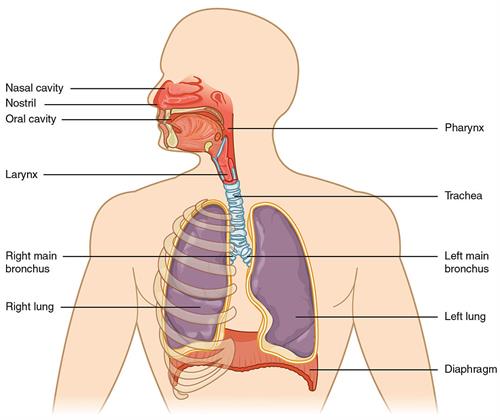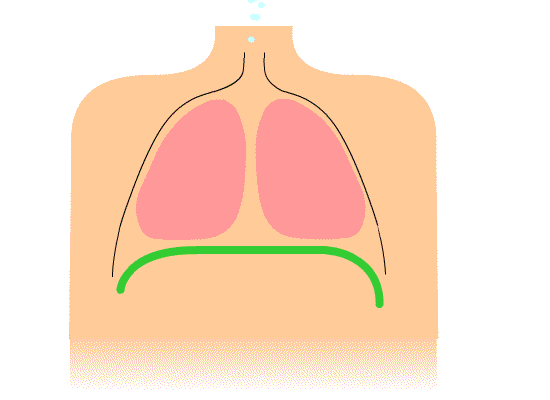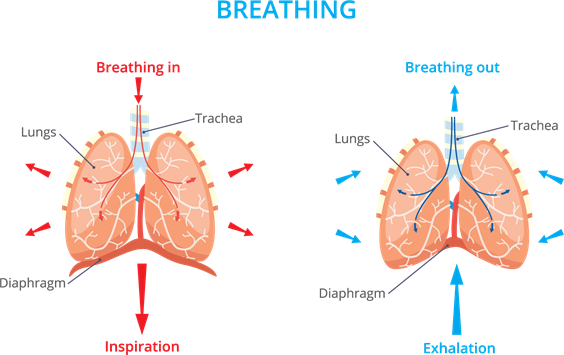PDF chapter test TRY NOW
What is organ system?
The group of organs that functions together and perform a particular function is called an organ system.
The respiratory system, circulatory system, digestive system, nervous system, endocrine system, reproductive system, etc.

Human organ systems
The Respiratory System
Our respiratory system is responsible for exchanging gas inhaling \(O_ 2\) and exhaling \(CO_ 2\).

Human respiratory system
The following organs are the parts of respiratory system, which is located in the thoracic cavity or chest cavity:
1. Nostrils or nose: We inhale and exhale through nostrils lined with the secrets of the cells cilia and mucus makes sticky and moist. These both trap the dust and germs, which enters through the inhaled air. And, also keeps warm our nostrils.
2. Pharynx or throat: The part which attaches the trachea with the nasal cavity and runs down to the lungs through wind pipe or trachea.
3. Larynx: This part present in between the pharynx and trachea, commonly known as a "voice box", which produce sound by vibrating the tissues present inside of it.
4. Trachea or windpipe: The trachea is an elastic, narrow tube that allows an inhaled air enters the lungs by the structure called bronchi.
5. Bronchi: The two branches of the trachea enters into the lungs and further divides into multiples small units called bronchioles.
6. Diaphragm: The dome shaped smooth muscle differentiates the thoracic cavity from abdominal cavity.
7. Lungs: A pair of lungs situated at the thoracic cavity purifies the CO\(_2\) blood into O\(_2\) blood by the simple diffusion in the alveoli. The lungs are spongy elastic sacs on each side of the thoracic cavity.
The left lung is smaller than the right lung allows room for the heart.
8. Alveoli: A very tiny workhorses made up of a single line of epithelial cells present inside of each lung. There are \(480\)million alveoli in the lungs, and the total area of the air sacs is above \(2000\)square feet. The primary function of the alveoli is the exchange of gases.
Respiration:
Before we are going to learn about breathing, we must understand respiration. Breathing is a part of respiratory function.
Respiration means, by using the inhaled air (oxygen), the cells are breaking down the stored energy into the active form called ATP (Adenosine Triphosphate).
Respiration is basically Two types.
- Aerobic respiration - This type needs oxygen to break down the stored energy into active energy.
- Anaerobic respiration - This type does not need oxygen to break down the stored energy into active energy. This type is also known as fermentation.
Mechanism of breathing:
Breathing is the process of inhaling and exhaling the gases through the nostrils.

Illustration of breathing
Breathing rate:
It is the number of times a person breathes per minute.
In human beings the rate of breathing or breathing rate is not always constant. This rate increases when there is high demand of energy by the body.
This can be explained by a small activity:
Count the number of times you inhale and exhale (breathing rate) at various times such as when sitting, while walking and while running. You will notice that the rate of breathing will be varying in all these conditions and will be the highest during running. This concludes the person are using more energy to perform the particular action and intakes more amount of oxygen.
An adult human breathes 15 to 18 times in a minute on an average. When a person performs heavy exercises the breathing rate increases up to 25 times per minute.
Inspiration or Inhalation:
Inhalation means taking oxygen inside through nostrils. The processes of inhaling are following:
- The sternum pushed up and outward,
- The diaphragm is pulled down and goes flat,
- The volume of the thoracic cavity increases, and pressure decreases,
- The air outside the lung flows into it.
Expiration or Exhalation:
The process of expelling the carbon dioxide from the body. The steps are as follows:
- The sternum becomes normal,
- The diaphragm relaxes to dome shaped,
- The volume of thoracic cavity decreases, and pressure increases,
- Air rushes out of the lungs.

Inhalation & Exhalation
Reference:
https://commons.wikimedia.org/wiki/File:2301_Major_Respiratory_Organs.jpg
https://commons.wikimedia.org/wiki/File:Clavicular_breathing.gif
https://pixabay.com/vectors/lungs-diagram-anatomy-body-human-41562/
